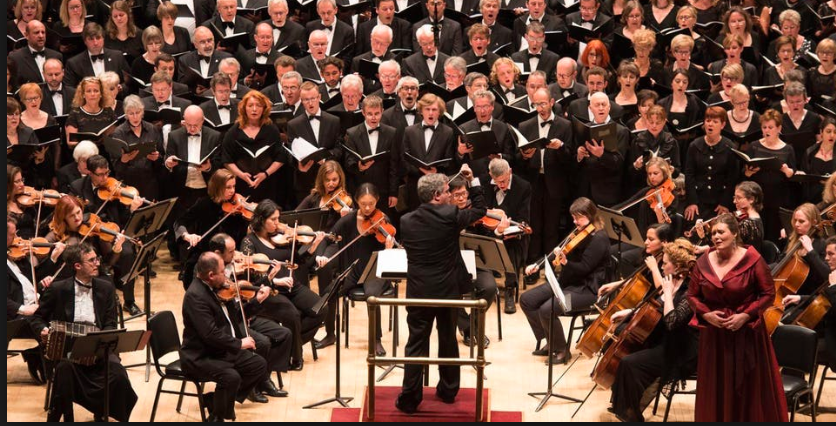Distinguished Concerts International New York (DCINY) presents¡Buena Onda! Music from South America in Review
María Guinand, guest Conductor; Martín Palmeri, composer/conductor; Saul Zaks, guest conductor; Alberto Grau, DCINY Composer-in-Residence
Carla Filipcic Holm, soprano; Kirsten Allegri Williams, mezzo-soprano; Shawn Mlynek, tenor; André Chiang, baritone
Daniel Binelli, Bandoneón
Distinguished Concerts Orchestra and Distinguished Concerts Singers International
Carnegie Hall, Stern Auditorium, New York, NY
June 23, 2019
There certainly was plenty of buena onda (good vibes) in DCINY’s final offering of the season, another typically well-sung, perhaps overly generous, program of massed choirs. The vibes were provided by two distinguished Venezuelans: Alberto Grau (born in Spain) and María Guinand; and two eminent Argentinians: Martín Palmeri and Saul Zaks. The international contingent was particularly varied, with Netherlands, Brazil, Argentina, Switzerland, Austria, Germany, Hong Kong, France, United Kingdom, and Russia represented. In fact, the only flaw I could find in this afternoon of music was in myself, a certain cultural distance that caused me to give myself a few sermons (silently) during it.
Whatever shortcomings Venezuela may have as a nation-state at the moment, they have certainly mastered bringing a healthy, fun relationship to music into the lives of children, mainly through the seemingly miraculous educational method called El Sistema, which has produced, notably, Gustavo Dudamel, and many others. Both Mr. Grau and Ms. Guinand are veteran musician-teachers within the system.
Mr. Grau’s music incorporates bodily movements (often called eurhythmics) to go along with the rather simple folk and childlike tunes he employs. The Cinco Canciones Infantiles is a reworking of music about El San Pedro (Saint Peter), whose festival parranda takes place on 29 June. A few centuries ago, in joyful thanks from a slave mother whose daughter was cured of a severe fever through prayer, she promised to honor the saint with song and dance. The choir was called upon to whoosh, clap, and otherwise move rhythmically, which they did with unflagging enthusiasm. Solo groups taken from the larger choir sang with assurance. Their leader, Ms. Guinand, led the proceedings with a very holistic atmosphere; how lucky these young musicians are to be exposed to such a master. She elicited myriad colors and real, subtle diminuendos from the choir.
The same forces stayed in position to render Mr. Grau’s Opereta Ecológico, in which four natural things: wind, river, sea, and tree, all extol their own value in poetic lines. His style is consistent- more eurhythmics and good humor. At a time when the earth’s very future habitability is being called into question, these little sermons are more relevant than ever.
A pause was needed to change out the children’s choir for adults and prepare for Martín Palmeri’s first offering, the celebrated Misatango. As I mentioned in my review of his Tango Credo (April 30, 2017), the tango, a sublimated erotic ritual dance involving great contrasts of attraction and repulsion, seems a “wrong fit” for the Catholic Mass. That’s where one of those “self-sermons” came in for me: I realized that the Baroque excesses of Bach and the high-Classical operatic styles of Haydn and Mozart were also once considered “inappropriate” music for worship, as compared with the sobriety of Palestrina’s counterpoint. So, time moves on, and it’s best to be flexible about such matters!
Carla Filipcic Holm, a large-voiced soprano (but one with control and shadings) has long been associated with this composer and work, and she delivered beautifully, as did bandoneón player Daniel Binelli. The feeling and sabor were perfect.
After intermission, Mr. Palmeri presented (from the keyboard as he had done in the Misatango) the other four newly-composed movements of his Gran Misa, again in full tango style—the conductor was the excellent Saul Zaks. (Credo and Gloria have been performed before.) Oboe and trumpet (instruments not shunned by Bach, but not customarily found in tango bands) were given pride of place. Mr. Palmeri’s orchestration is ingenious and interesting, and the choral work was very good. If performed in its entirety, all six movements would form a nearly two-hour work. Two hours of tangos is a lot for me- I do apologize for my limitation, I certainly need an Argentine immersion experience! All the soloists (Ms.Holm, Kirsten Allegri Williams, Shawn Mlynek, and André Chiang) were excellent, and the large supportive audience went wild with their admiration, and why wouldn’t they?

